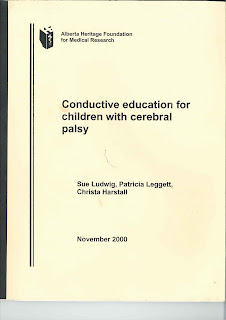Ludwig, S, Leggett, P Harstall, C. (2000) Conductive Education for children with cerebral palsy. Edmonton: Alberta Heritage Foundation for Medical Research.
This is the only review so far to make a major critical proposal to better the quality of how evaluations done in Conductive Education. There were relatively few studies to look at, with five being carried out in Australia, three in the UK, and one in Ireland.
Why was it done?
The Health Technology Assessment (HTA) Unit of the Alberta Heritage Foundation for medical research was requested by Alberta Children’s Services and Alberta Health & Wellness to assess the evidence of effectiveness of Conductive Education for children with cerebral palsy
A review was requested to help the ministries answer the question, ‘is Conductive Education as a learning approach or therapeutic intervention safe and efficacious for children with disabilities such as cerebral palsy…?…The HTA Unit conducted a systematic search for and critical appraisal of published scientific evidence regarding the impact of Conductive Education on the overall learning and health status of children with cerebral palsy. (p.1)
Outline
The review gives an outline of its parameters followed by a brief description of Conductive Education and its origins and then goes on to look at six primary studies and three studies that examined parental reactions, perceptions and satisfaction.
It sets out their summaries in the form of a table, giving the type of study, (e.g. randomized or non-randomized, controlled, descriptive), setting, (e.g. UK, Australia), the methods, and authors’ conclusions, and then discusses each one in more detail.
This is followed by a summary of the main, conclusions, a discussion of these, and the authors’ conclusions. And, of course, a list of references. Also included are several appendices on methodology, cerebral palsy, CE models in Alberta, primary and parent studies (including outcomes and comments). All set out as tables.
It is noted that there were few reasonable studies to consult at that time (as is still the case) and the evidence on the efficacy of CE is sparse and of poor quality
Their radical suggestion for the betterment of such evaluations was ‘manualisation’, I.e. actual stating in he form of a ‘manual’ what is was that was actually done with the subjects in the intervention being evaluated (a well known measure in clinical psychology). If one does this then it may even be possible that studies might be replicated. If not, then they cannot be. It would also offer readers of reviews to form thie own judgements of how far then work being evaluated in fact merit the name of Conductive Education in the first place (not a lot, probably in many cases.
As far as I know, no later studies have taken up this suggestion.
The full report can be viewed at http://www.ihe.ca/publications/library/archived/conductive-education-for-children-with-cerebral-palsy/





No comments:
Post a Comment